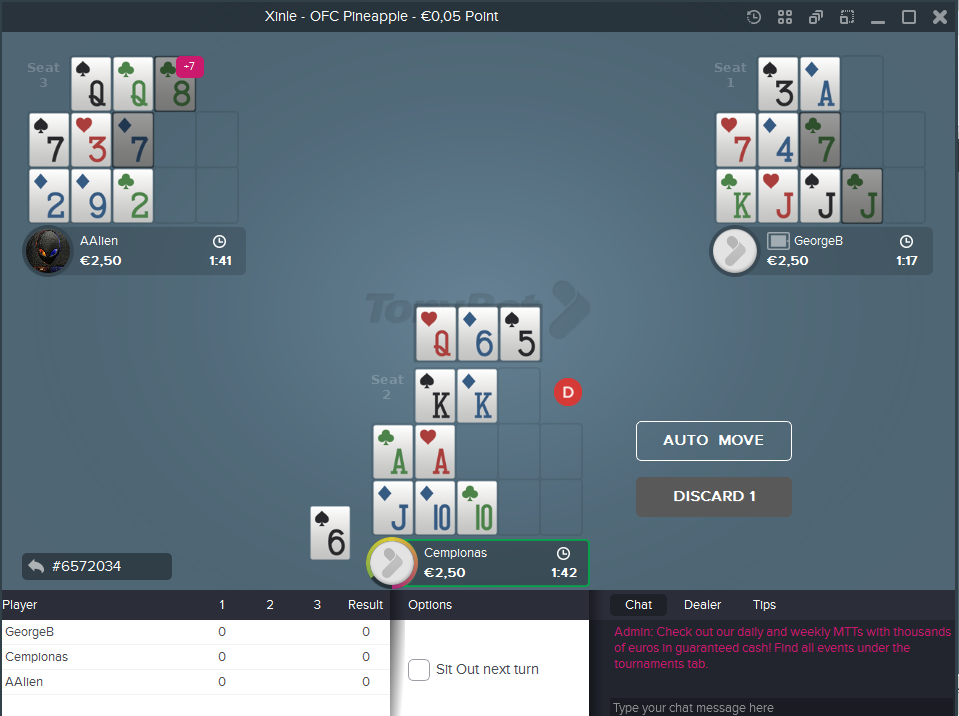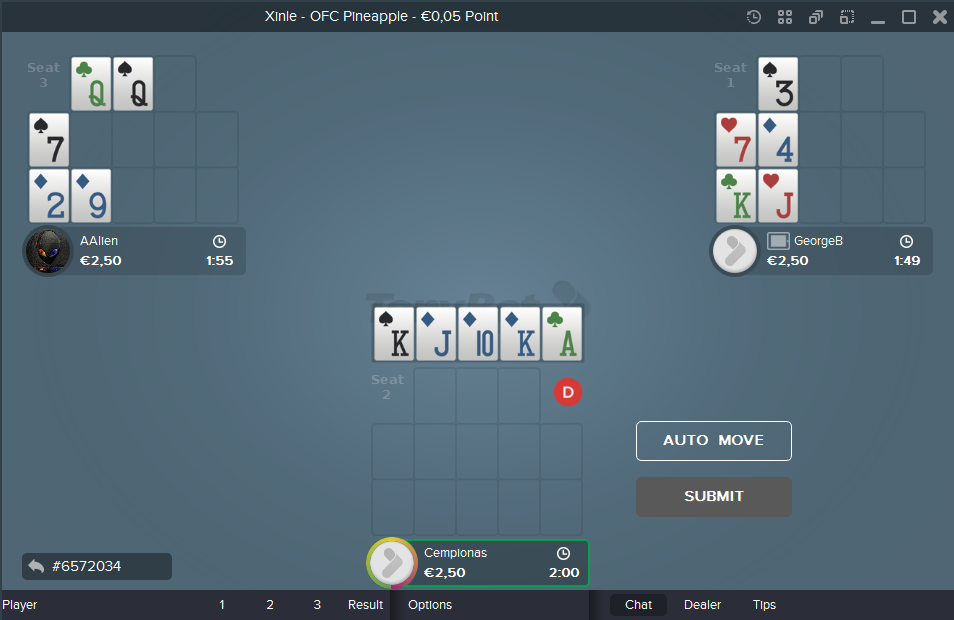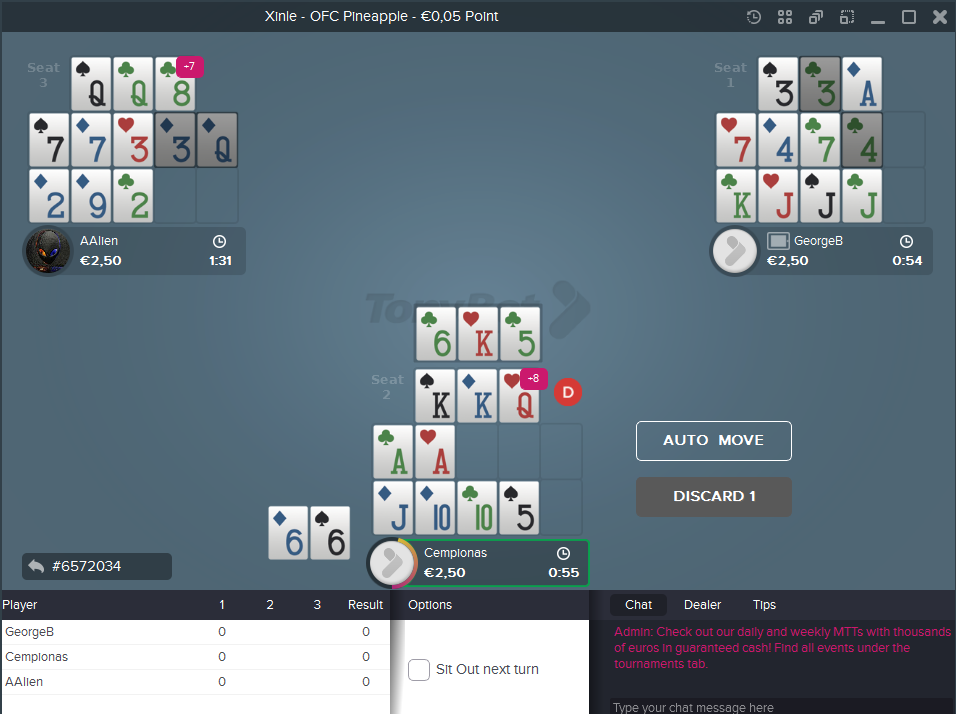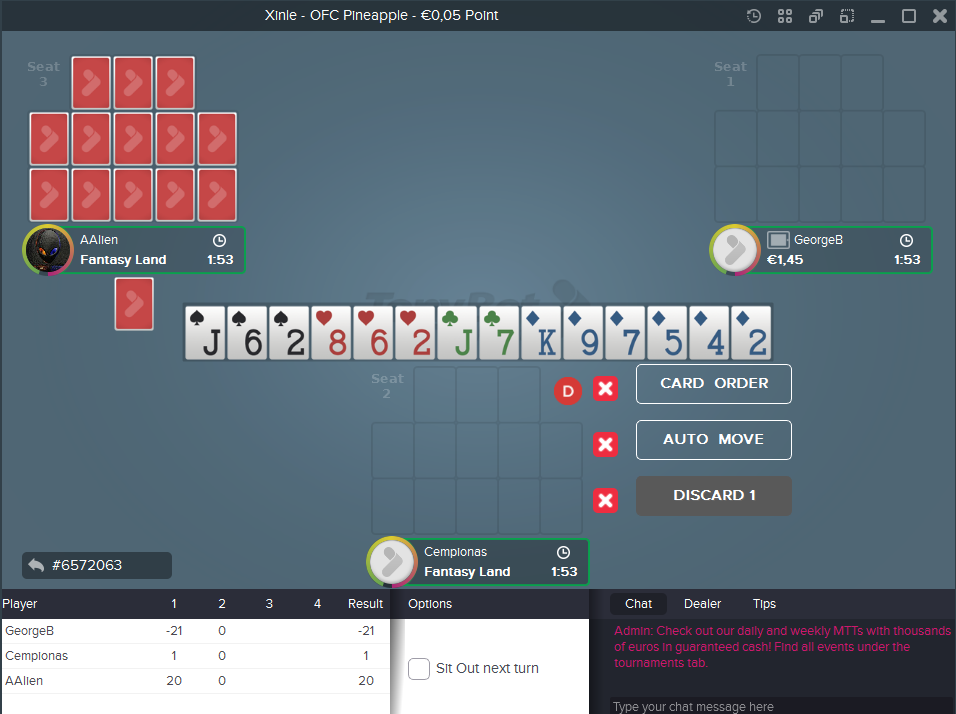 First 5 cards. A very big advantage is that we have position in this case, which is a huge advantage for us. Now let's look at what our opponents have laid out. Player “AAlien” placed the cards first, without any information about our cards, and chose a very aggressive line. In this case, his chosen line is not “bad,” but it is very aggressive, and the opponent has a very high % chance of making the wrong combination and just burning out. In this case, he only has two clubs and doesn't know how many are already out of the game. Also, the middle is very weak; if instead of 7 he had an A or K, it would be much better. In this case, I would choose the following line: 2 9 / QQ7 (29 in the middle, QQ7 at the bottom). The reason for a safer and more passive line is that he is playing completely without any information.
First 5 cards. A very big advantage is that we have position in this case, which is a huge advantage for us. Now let's look at what our opponents have laid out. Player “AAlien” placed the cards first, without any information about our cards, and chose a very aggressive line. In this case, his chosen line is not “bad,” but it is very aggressive, and the opponent has a very high % chance of making the wrong combination and just burning out. In this case, he only has two clubs and doesn't know how many are already out of the game. Also, the middle is very weak; if instead of 7 he had an A or K, it would be much better. In this case, I would choose the following line: 2 9 / QQ7 (29 in the middle, QQ7 at the bottom). The reason for a safer and more passive line is that he is playing completely without any information.
Looking at the first opponent, we cannot say that he made a mistake; we can only see that he chose the most aggressive line. However, looking at the second opponent, we immediately see fundamental Chinese poker mistakes. Although his cards seem quite scattered and it is a poor starting hand, let's look in more detail. All his cards are 100% live (when he was placing them, our analyzed player's cards were not yet out). So all his cards are live, and all hearts are live if he wants to go for a flush. Another very important point is that he has a K, and so far, they are all live. So what should we pay attention to? First, we see that the first opponent has placed two queens at the very top, so the probability that “GeorgeB” will draw two more queens is very low, so his live K fits very well in the top box. Also, it is very important to note that when he places his hand, no A has come out yet, so there is a high probability that he will manage to draw AA and thus form a safe line with KK at the top and AA in the middle. The perfect placement would be K at the very top, playing for fantasy. It is also important to mention that by collecting KK, we not only get +8 points and fantasy but also win a point against the opponent's queens and the possibility to scoop. In the middle, you should place 43, two live small cards, as they are perfect for two pairs and there is also a straight possibility. And leaving 7J at the bottom is a great opportunity to collect a flush or straight or two higher pairs than in the middle line. Looking at our second opponent's placement, we can assume that he is not familiar with the subtleties of pineapple poker and is placing more like classic Chinese poker, where the top box is not as important as in pineapple poker.
So at the table, we have one aggressive player and one complete fish who doesn't really know what he's doing, so it's definitely a great place to play. Now let's talk about our hand. Not only do we have position, but we also get a monster!! It's very nice to see such a hand. Again, a very important factor is that we have an A and they are all live, so there is a high probability that we will draw another one. So, immediately we want to place A in the middle. Placing A in the middle, we can very calmly place KK at the top. With all A live, there is a very high probability that we will safely finish our hand by placing AA or two pairs in the middle. Also, KK at the top wins against the opponent's QQ and the opponent's 3. These are additional two points for us and the possibility to scoop. At the bottom remains JT, which is also very nice because we have a straight/flush possibility and also to collect two pairs.
So in this deal, we have both the advantage of position and the advantage of cards and another player at the table who doesn't understand what he's doing.

So our first three cards, when we need to discard one, but before looking at them, let's review what our opponents got and placed. The first opponent placed a pair at the bottom and a more live small card in the middle. His line is very clear; he is trying to save his hand from burning and to get fantasy. Meanwhile, the second opponent is again “messing up.” J at the bottom is really good, but A at the top already shows that the opponent is not very strong in this game. The problem is not that A at the top is bad, the problem is that the opponent initially chooses a bad line, and in the second deal places A at the top, which shows that the player has no logical understanding of the game and no plan for what to do in later deals when receiving certain cards.
The only bad thing for him is that he placed both A and J, two essential cards for us. So we are left with two A and only one J.
But luck smiles on us again, we get two vital cards for us. A in the middle line, which guarantees that we won't burn with our KK at the top, and T at the bottom. Now we have the easy part left, we just need any pair at the bottom to not burn, collect +8 points, and get fantasy.
 We received three more cards each. Since we have a very big advantage – position, let's start again with the review of the opponents' cards. The first opponent placed 7/8. It is very important; we have to think not only about what and why the opponent is placing but also about what card the opponent might have discarded. In this case, again, the opponent chooses a strange decision. The opponent has a completely live card: 8, which he could place in the middle line. This would increase his chances of survival. Now he needs to draw either a 3 or a smaller pair than 9 in the middle line (since the highest card in the lowest line is 9). So there is no reason for the opponent to place it this way. By placing a completely live card at the top, he only increases his chances of burning. A good sign for us. Considering his chosen line, there is a very high probability that he will just burn this round.
We received three more cards each. Since we have a very big advantage – position, let's start again with the review of the opponents' cards. The first opponent placed 7/8. It is very important; we have to think not only about what and why the opponent is placing but also about what card the opponent might have discarded. In this case, again, the opponent chooses a strange decision. The opponent has a completely live card: 8, which he could place in the middle line. This would increase his chances of survival. Now he needs to draw either a 3 or a smaller pair than 9 in the middle line (since the highest card in the lowest line is 9). So there is no reason for the opponent to place it this way. By placing a completely live card at the top, he only increases his chances of burning. A good sign for us. Considering his chosen line, there is a very high probability that he will just burn this round.
The second opponent this time places without mistakes, of course, what mistakes can there be when you draw the right cards 🙂 J at the bottom into trips, leaving him only one out for a full house at the bottom. And a pair in the middle. Although the opponent started poorly, his hand is safe, and if the first opponent burns, he will already earn +6 points from him, not counting bonuses. And it is also likely that he will not lose all lines to us, as his third J greatly reduces our chances of collecting a full house.
So our hand. Now our main headache is how to strengthen the bottom so that the hand does not burn. The second opponent placed the third J. This means we have only 2 tens left at the bottom. So we must provide additional outs. Looking at our cards: Q, there is only one left, not suitable. 6 – two, okay, everything is fine. 5 – all three live, ideal situation. We place a completely live card at the bottom to increase the % of drawing a second pair.
Since we will no longer be able to strengthen the top row (if we place KKK, we will always burn). We place any card. Both cards do not change anything for us or the opponents, but I have a habit of always placing the higher one.
So after 5+3+3 cards, we are in a very good situation. We will still receive 6 cards and have 5 outs at the bottom (T/T/5/5/5). Meanwhile, there is a high probability that the first opponent will burn, as he not only needs to draw one of the 5 outs at the bottom but also in the middle, where he has only 2 outs left (3/3). Of course, there is a probability that he will draw a pair in the middle. However, that pair will have to be smaller than the second pair at the bottom.

The penultimate card deal. The first opponent draws one of the two remaining 33. If he had not managed to do this move, his situation would have been very complicated.
Meanwhile, our second opponent makes a mistake again. This is a very typical beginner's mistake when cards are placed without paying attention to what our opponents are placing. In this case, whether GeorgeB has //3/3/A// or //2/3/A// at the top, it changes nothing. For the 33 pair at the top, he does not get any bonus and loses to both his opponents. So in this case, he needs to think of something else.
It is important to note that there is one live A left. So if GeorgeB collects AA3 at the top, he not only gets +9 points and wins against both his opponents but also gets the right to place fantasy. So by blocking the top, he loses a very big opportunity to make his hand a winning one.
Kai kurie žaidėjai ginčysis su manimi, sakydami, kad jis pasilieka laisvas linijas dviems pilniems namams, tačiau jūs esate visiškai neteisus ir tuo labai lengva įsitikinti paskaičiavus autus. Apačioje jam yra gyva tik viena korta, vienas K (kai oponentas dėliojo, dar nebuvo mano kortų). Taigi, apačioje vienas autas ir galimybė surinkti +6 taškus ir laimėti prieš mus abu. Vidurinėje linijoje likę du autai, bet norint jais pasinaudoti ir uždirbti +12 taškų būtina apačioje ištraukti karalių. Tad norint surinkti du pilnus namus reikės ištraukti 1/1 ir 1/2 likusių kortų.
Tuo tarpu mūsų kortos vėl mums palankios, ištraukiame mums reikalingą 5, kuris praktiškai jau garantuoja, kad nesudegsime. Nors ir pralošiam prieš antrąjį oponentą pirmą ir antrą eiles, tačiau KK viršuje ir fantazija su kaupu tai kompensuoja. Prieš pirmąjį oponentą yra didelė tikimybė, kad jis sudegs ir mes surinksime +14 taškų +fantaziją.
Taigi 5 keliauja į apačią. Ką dėti per vidurį? Tokią kortą, kuri nesugadintų reikalo, nes iš paskutinio traukimo mes privalėsime padėti dvi kortas į vidurį, todėl būtina dėti labiau mirusią kortą, kad netyčia neištraukti antros poros per vidurį.
Taigi paskutinis dalinimas. Pirmasis oponentas ištraukia net ne vieną jam tinkamą kortą, o dvi ir laimi prieš mus abu toje eilėje ir dar gauna bonus +6 taškus. Tai nėra retenybė taip gerai ištraukti pabaigoje ypač jeigu jums yra likę daug gyvų kortų, tačiau vistiek oponentas šiuo atveju labai rizikavo. Antrasis oponentas jau nebesustiprina savo kombinacijos, tačiau galėtų dar suklysti padėdamas 4 per vidurį. Atrodo iš fantastikos srities, bet mažuose limituose žaidėjai sugeba padaryti net tokias klaidas ir sudegti kai jau atrodo, kad neįmanoma. Taigi sekantis žingsnis taškų skaičiavimas.

TonyBet Poker labai gražiai pateikia taškų skaičiavimą, matome kas laimi kiekvienoje linijoje. Kiek gauname už bonusus ir kiek gauname bendrai. Plačiau apie tai kaip skaičiuojami taškai kiniškame pokeryje galite rasti čia.
Taigi, nors ir startavome labai geroje pozicijoje ir pradžioje labai gerai krito kortos, tačiau užbaigėme tik su +1 tašku. Tačiau nėra ko liūdėti, pirmam oponentui sekėsi, tad ilgajame periode mes tikrai iš jo uždirbsime daugiau.
Taigi einame dėlioti fantazijos.
Fantazija – tai toks bonusas, kurį mes gauname, jeigu mums pavyksta žaidimo metu sudėti viršutinėje eilėje porą QQ arba aukštesnę kombinaciją ir nesudegti. Šiuo atveju tiek mes su KK, tiek mūsų oponentas su QQ abu gavome fantazijas. Dabar mes gauname visas 14 kortų iš karto į ranką ir turime jas sudėlioti į savo eiles. Toks kortų matymas iš karto suteikia labai didelį pranašumą prieš mūsų oponentus kurie dėlioja kortas paprastu būdu.

Štai galutiniai skaičiavimai po fantazijos. Labai nuskilo mums čia, kad pirmasis oponentas, kuris dėliojo fantaziją visur sudėjo mažesnes kombinacijas negu mes, todėl mes papildomai uždirbome iš jo +3 taškus. Šioje rankoje turėjome uždirbti dar daugiau taškų, bet pas antrąjį oponentą tiesiog pasibaigė pinigai. Tad mes neuždirbome maksimaliai tiek pinigų kiek galėjome.
Tai buvo antrasis straipsnis apie kinišką pokerį, kuri jums parengė “Brilijant”. Pirmajame straipsnyje mes apžvelgėm startinių penkių kortų išdėstymą, o sekančiame straipsnyje žvilgtelėsime į kiniško pokerio matematiką ir kaip suskaičiuoti mums tinkančias kortas.






